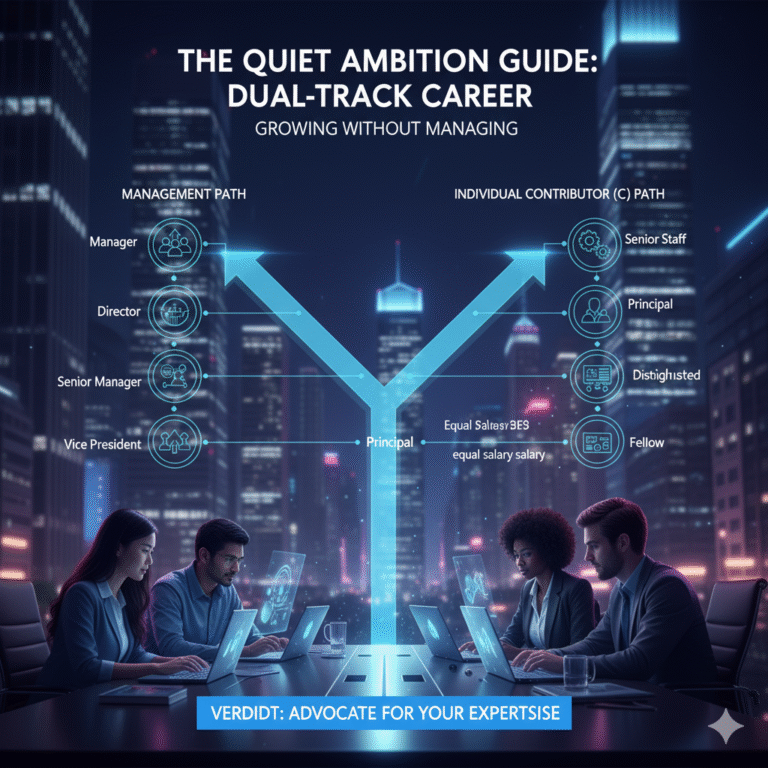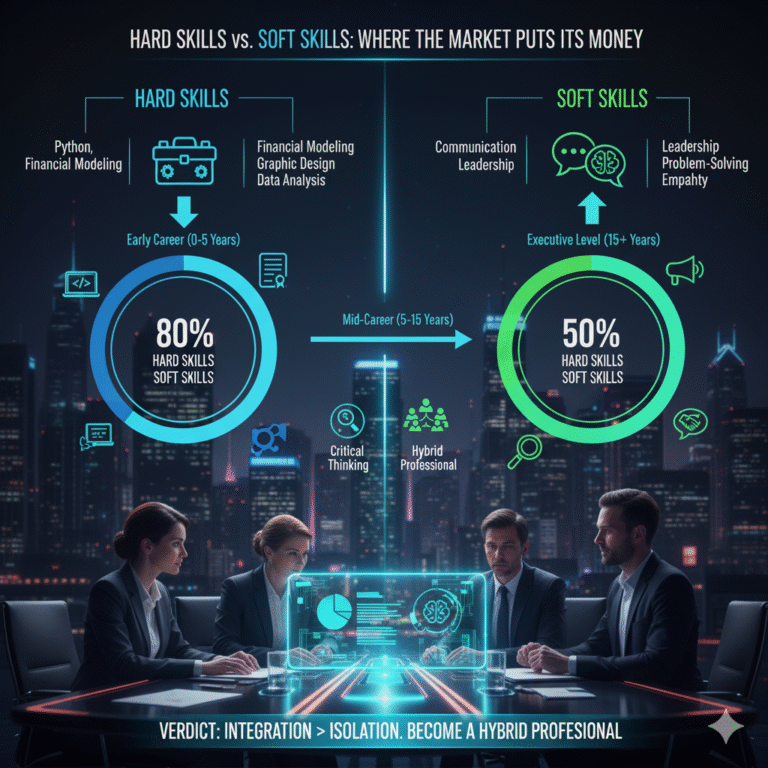Career Transition After 40: The Complete Roadmap to Change Fields Safely and Strategically
There is a pervasive, unspoken myth in our professional culture: your 20s are for exploration, your 30s are for building, and your 40s (and beyond) are for maintenance. You’ve climbed the ladder, you have a mortgage, a family, and a stable salary. You’re supposed to be on “cruise control.” But for millions, this “cruise control” feels like a trap. You’re bored, unfulfilled, and eyeing a completely different field, but a terrifying voice says, “It’s too late.”
This is the “golden handcuffs” dilemma. You feel you must choose between meaning and security. What if that’s a false choice? A career transition after 40 is not a reckless leap; it is a strategic, calculated pivot. It’s not about “burning the ships” and starting from zero. It’s about leveraging 20 years of experience to enter a new field, not at the bottom, but at the middle or even the top.
This is not a guide for “quitting your job.” This is a complete, step-by-step roadmap for executing a safe, strategic, and successful mid-career transition. Forget “starting over.” It’s time to *leverage* over.
The “Over-40 Advantage”: Why You Are Not Starting from Zero
The single biggest mistake mid-career professionals make is undervaluing their existing assets. You are not “starting over” like a 22-year-old graduate. You are a strategic asset with 20 years of proof.
Your “Soft Skills” Are Now “Critical Skills”
The “soft skills” that were a footnote on your first resume are now your primary selling point. A 22-year-old needs to be taught these. You have mastered them:
- Stakeholder Management: You know how to navigate politics and manage expectations (from a difficult client to a demanding VP).
- Project Leadership: You know how to take a vague idea, build a plan, and get it across the finish line.
- Communication & Empathy: You know how to mentor a junior, resolve a team conflict, and present clearly to an executive.
These skills are non-negotiable in any high-value field. You are not “entry-level” in any room you walk into.
Your “Pattern Recognition” is Your Superpower
You have seen this before. You’ve seen projects fail. You’ve seen products launch successfully. You’ve navigated two recessions. This “pattern recognition” gives you *judgment*. A junior employee can run a report; you know what the report *means*. This is the wisdom companies are desperate to pay for, and it’s impossible to teach in a bootcamp.
Your Network is Your Net Worth
You have two decades of contacts: former bosses, old colleagues, vendors, and clients. This network is a safety net and an accelerant. A 22-year-old has to “cold apply” on LinkedIn; you can “warm call” a former colleague for insight and an introduction.
The 5-Step Strategic Roadmap for a Safe Transition
A safe transition is not a leap; it’s a series of small, calculated steps. It’s a bridge, not a jump.
Step 1: The “Inventory & Audit” Phase (What You Keep)
Before you learn anything new, you must audit what you already have. Get a blank document and create two columns: “Skills I Love Using” and “Skills I Hate Using.”
- You might “hate” being an accountant (the field) but “love” the *skill* of “finding the story in a messy spreadsheet.”
- You might “hate” being in sales (the job) but “love” the *skill* of “building rapport and solving a client’s problem.”
This audit reveals your “transferable skills.” Your goal is to find a *new field* that maximizes the skills you love and minimizes the ones you hate. This is “Skill Bridging.” (e.g., An “Accountant” pivots to “Data Analyst”; a “Salesperson” pivots to “Customer Success Manager”).
Step 2: The “Test Drive” Phase (De-Risking the New Field)
Never, ever jump into a new field blind. The fantasy is always rosier than the reality. You must “test drive” the new career before you quit your old one.
- Take a “Micro-Project”: Use a platform like Upwork or ask your network for a small, 10-hour freelance project in the new field. Do you actually *like* the day-to-day work?
- Get a Certification: A $500 certification (like a PMP for project management or a Salesforce Admin cert) is a low-cost way to test your aptitude and interest.
- Shadow a Professional: Use your network to ask someone in the target role if you can “buy them lunch” and interview them (or even shadow them for a day).
This phase is cheap, fast, and can save you from a multi-year mistake.
Step 3: The “Skill Gap” Phase (Building the Bridge)
After your test drive, you’ll have a clear “skill gap” (e.g., “I have the leadership skills, but I don’t know the specific software”). Now you upskill, but you do it surgically.
Do not get a four-year degree. You need targeted, high-value credentials.
- Bootcamps: (e.g., for UX Design, Coding, Data Science). Intensive, fast, and project-based.
- Executive Certifications: (e.g., from a university extension). Adds credibility and a new network.
- Software-Specific Certs: (e.g., HubSpot, AWS, Google Ads). Proves you have the specific hard skills required.
Step 4: The “Financial Moat” Phase (Building Your Runway)
This is the most critical, non-negotiable step. *You cannot make a good strategic decision from a place of financial panic.* You must build a “financial moat” or “runway.” This is a separate savings account containing 6 to 12 months of your essential living expenses. This “runway” is your freedom. It gives you the power to say “no” to a bad offer and the time to find the *right* one. Do not even *think* about quitting until this moat is full.
Step 5: The “Re-Branding” Phase (Changing Your Narrative)
You are now ready to apply. But you cannot use your old resume. You must “re-brand” yourself. Your LinkedIn headline is your new billboard.
- Old Headline: “Senior Sales Manager at ACME Inc.” (Your past)
- New Headline: “Customer Success Leader | Leveraging 15 Years of Sales & Relationship Management to Help SaaS Companies Reduce Churn” (Your future, built on your past)
Your resume summary must tell this new story, explicitly connecting the dots for the recruiter. “My 20 years in finance have given me a deep understanding of data, which I am now channeling into a new career in Data Analytics, backed by a [New Certification].”
Common Traps to Avoid (The “Over-40” Pitfalls)
Trap 1: The “Entry-Level” Application
Do not apply for “entry-level” jobs, even if the field is new. You will be seen as “overqualified” (and expensive), and you will be bored in 6 weeks. Target *mid-level* or “strategic” roles that *need* your 20 years of leadership and judgment, and are willing to train you on the 10% hard-skill-gap you have.
Trap 2: The “Salary Golden Handcuffs” Mindset
You will likely take a temporary pay cut. You must reframe this. It is not a “cut”; it is a *strategic investment* in your next 20 years of career fulfillment and (likely higher) future earnings. Your financial moat (Step 4) is what allows you to make this investment comfortably.
Trap 3: Hiding Your Age or Experience
Do not remove dates from your resume. Do not try to “act” 25. This screams insecurity. *Own* your experience. Frame it as what it is: pattern recognition, wisdom, judgment, and stability. In a volatile market, you are the *safe pair of hands* that every company needs.
Conclusion: Your Second Act is a Strategic Pivot, Not a Crisis
A career transition after 40 is not a step back. It is a strategic pivot to a new, more meaningful ladder. You are not “starting over”; you are combining your deep, proven expertise with new, targeted skills. You are not a “risk.” You are a seasoned professional who has done the strategic work to de-risk your own transition. Stop waiting for “someday.” Build your moat, test-drive your theory, and go get your second act.







